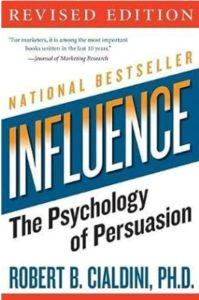Reading Notes For:


Part 1: The Introduction
This is a summary of my reading notes from Influence by Robert Cialdini.
“Influence: The Psychology of Persuasion” by Robert Cialdini is a timeless masterpiece that unveils the secrets of persuasion. Cialdini delves into human psychology, revealing six principles of influence that guide our decisions. What sets this book apart is its practicality; it offers actionable strategies for marketing, sales, and communication. Cialdini’s storytelling prowess makes the concepts engaging and memorable. It remains relevant despite its 1984 publication, offering a solid foundation for understanding human behavior in a changing world. Importantly, “Influence” emphasizes ethical persuasion, making it a must-read for anyone seeking to influence others with integrity.
Ladies and gentlemen, we’ve embarked on an exciting journey through the intriguing world of human behavior and the principles of persuasion. Now, let’s delve deeper into the hidden forces at play, which often lead us to say “yes” without even realizing it.
In our exploration of these principles, we’ve learned that our automatic tapes are usually shaped by psychological principles and stereotypes that we’ve been exposed to from a very young age. They’re like scripts in our minds, guiding our responses without us even recognizing their power. But rest assured, others can detect and wield these principles as powerful weapons of automatic influence.
There’s a group of people out there who are masters of this art. They move from one social encounter to another, effortlessly persuading others to comply with their wishes. Their success is nothing short of dazzling. What sets them apart is their ability to structure their requests using the weapons of influence hidden within our social environment.
Sometimes, all it takes is one well-chosen word, one that engages a powerful psychological principle, to set our automatic behavior tapes in motion. These exploiters have learned to profit from our tendency to respond mechanically to these principles. They know how to trigger our automatic responses.
Consider the tale of the Drubeck brothers, Sid and Harry, who owned a men’s tailor shop back in the 1930s. Sid, the salesman, used a clever trick. He pretended to have a hearing problem and asked customers to speak louder. When it came time to quote the price of a suit, Harry, the head tailor, exaggerated it. Sid would then pretend to mishear, offering a much lower price. Many customers, driven by the “expensive equals good” stereotype, would rush to buy the seemingly discounted suit.
But what’s common among all these weapons of automatic influence? Well, there are a few components we need to understand. First, there’s the almost mechanical way these weapons can be activated, making them ripe for exploitation. Second, the exploiters don’t need to exert much effort; they merely tap into the existing sources of influence in a situation. This subtle manipulation often goes unnoticed, even by the victims themselves.
Now, let’s talk about the contrast principle, a fascinating aspect of human perception. This principle affects the way we perceive the difference between two things presented one after another. If the second item is significantly different from the first, we tend to see it as even more different than it actually is.
Think about it in terms of lifting weights. If you lift a light object before a heavy one, the second one will feel even heavier. The same applies to our perception of attractiveness. If we talk to a beautiful person at a party and then meet someone less attractive, we tend to undervalue their attractiveness. This principle even impacts our satisfaction with our own partners, thanks to the media’s bombardment of unrealistic beauty standards.
A classic experiment with perceptual contrast involves placing one hand in cold water and the other in hot water before putting both hands in lukewarm water. Even though both hands are in the same bucket, the one that was in the cold water will feel like it’s in hot water, and the one that was in hot water will feel like it’s in cold water.
What’s crucial about the contrast principle is that it’s nearly undetectable when exploited. For instance, retail clothiers use it strategically. When a customer comes in looking for a three-piece suit and a sweater, they show the expensive suit first. This makes the sweater, even if it’s expensive, seem more reasonable in comparison. Surprisingly, this approach leads customers to spend more on accessories after buying the suit.
So, whether it’s in retail, real estate, or various other aspects of our lives, the contrast principle continues to shape our decisions, often without us realizing it. It’s a powerful tool that savvy influencers use to their advantage.
In conclusion, our automatic responses are driven by a complex interplay of psychological principles and learned stereotypes. They can be triggered with a single word or by skillful manipulation of our perception through contrast. The world of human behavior is indeed fascinating, and understanding these hidden forces can empower us to make more conscious decisions in our daily lives. Thank you for joining me on this extended exploration of the secrets of persuasion and influence.
